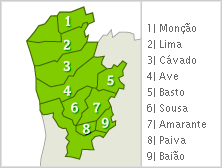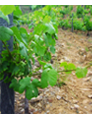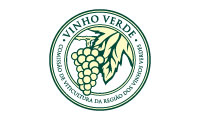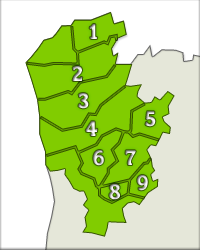The region’s exuberant vegetation – typical of a high humidity region – imparts a green tone to it; however, the name Vinhos Verdes (direct translation: green wines) owes its origin not only to the surrounding environment, but also to the type of wine produced in this region, which is typically acidulous, light, fairly alcoholic and has good digestive properties.
 Vinhos Verdes, the largest wine region in Portugal, is located in the north west of the country, coinciding with the region called Entre Douro e Minho (which is not a wine region). Bordered by the river Minho at north and by the Atlantic Ocean at west, the region has many hydrographic resources. The interior is made up of mountain ranges, the highest of which is the 1373 metre high Peneda.
Vinhos Verdes, the largest wine region in Portugal, is located in the north west of the country, coinciding with the region called Entre Douro e Minho (which is not a wine region). Bordered by the river Minho at north and by the Atlantic Ocean at west, the region has many hydrographic resources. The interior is made up of mountain ranges, the highest of which is the 1373 metre high Peneda.
The region’s soils are mainly granite and not very deep. They have high acidity and low level of phosphorus, resulting in a relatively low fertility. Throughout the centuries, however, the construction of terraces and the use of natural fertilisers have made them soils more fertile.
 As the region’s climate is influenced by sea breezes from the Atlantic Ocean, temperatures are mild throughout the year. Precipitation is high in this region, so don’t be surprised if it rains for several days in the summer (which explains the high level of atmospheric moisture).
As the region’s climate is influenced by sea breezes from the Atlantic Ocean, temperatures are mild throughout the year. Precipitation is high in this region, so don’t be surprised if it rains for several days in the summer (which explains the high level of atmospheric moisture).
Some of the oldest ways of training vines still survive residually in this region. One of them consists of planting the grapevines near a tree and letting them grow supported on its branches. Recent wine farms, however, opt for modern ways of training vines. Although the vine training systems traditionally used in the region did not stimulate the wines’ quality (they interfered with the ripening of the grapes and provided high acidity levels), one should not conclude that tradition said one should harvest the grapes before they ripen. The proof of that is that, in this region, the harvests were extended until the end of October / beginning of November. The white varieties most used in the production of the region’s wine are: Alvarinho, Loureiro, Trajadura, Avesso, Arinto (also known as Pedernã) and Azal.
The region’s boundaries were established at the beginning of the 20th Century and, nowadays, the Denomination of Origin is divided into nine sub-regions: Monção, Lima, Basto, Cávado, Ave, Amarante, Baião, Sousa and Paiva, each of them producing distinct types of Vinho Verde. In fact, the differences between the wines from different parts of the region are notorious. For instance, Monção’s Alvarinho is a full bodied, dry white wine, while the Loureiro from Vale do Lima is softer and more perfumed. The red wine produced in Vinhos Verdes, formerly the main wine in the region, is currently almost exclusively consumed by local populations. It is a very acid, red coloured wine produced from grape varieties such as Vinhão, Borraçal and Brancelho, among others. It is much appreciated to accompany the region’s gastronomy.
-
 Comissão de Viticultura da Região dos Vinhos Verdes
Comissão de Viticultura da Região dos Vinhos Verdes
Rua da Restauração, 318
4050-501 Porto
Tel.: 22 607 73 00
Fax: 22 607 73 20
info@vinhoverde.pt
www.vinhoverde.pt/
Sub-regions

- 1| Monção
- 2| Lima
- 3| Cávado
- 4| Ave
- 5| Basto
- 6| Sousa
- 7| Amarante
- 8| Paiva
- 9| Baião
Curiosities
Vinho Verde
Some say the designation "Verde" (green) owes its origin to the wine's acidity and freshness, resembling unripe (green) fruit. Others affirm that "Verde" comes from the region's vegetation, which imparts a green tone to the soil, even in winter.First export
From the 17th Century onwards, exports of "Vinho Verde" to England have become regular. It is likely that the first wines to be exported were from the area of Monção and that the transaction was made through Viana do Castelo.Vine growing
In the 12th Century there was a great incentive to the growing of vines. In the foral (royal document) granted by D. Afonso Henriques to the men of Bouças (1172) it was declared that the plantation of vines was free of any duties for a period of five years, after which the duty would correspond to the 6th part of the wine harvested.


 Wine Regions
Wine Regions Vinhos Verdes
Vinhos Verdes Trás-os-Montes
Trás-os-Montes Douro
Douro Bairrada
Bairrada Dão
Dão Beira Interior, Távor...
Beira Interior, Távor... Lisboa
Lisboa Tejo
Tejo Península de Setúbal
Península de Setúbal Alentejo
Alentejo Algarve
Algarve Madeira
Madeira Azores
Azores
 Wine routes
Wine routes




